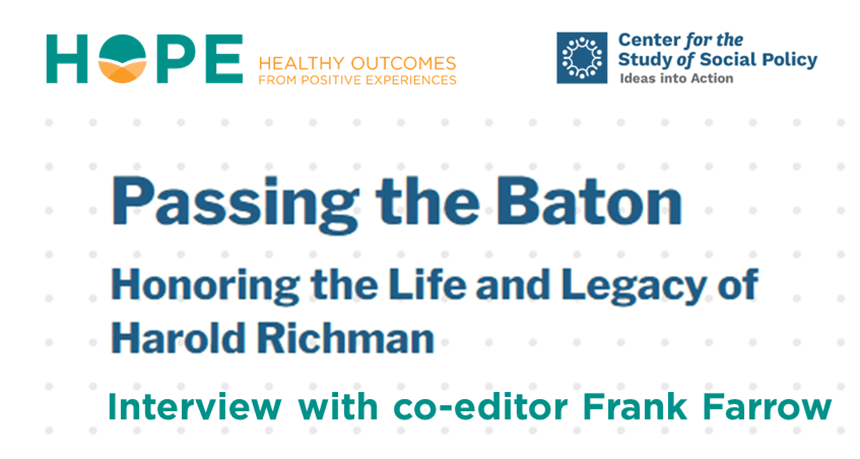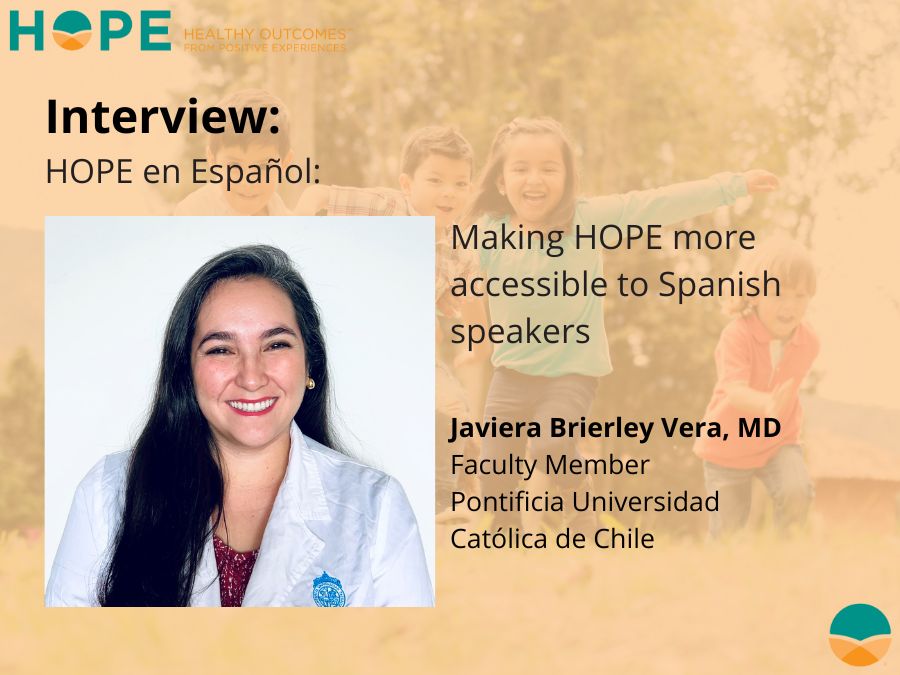
“Passing the Baton” is a collection of essays assembled by editors Mark Joseph, Frank Farrow, and Leila Fiester and posted on the website of the Washington DC-based Center for the Study of Social Policy. The collection is dedicated to Harold Richman, who committed his life and career to the quest to end poverty and inequality through policy and system changes. Each essay highlights an idea, program, or policy vision that embodies in the current day Harold’s goals and work. In the most recent essay Dr. Robert Sege discusses HOPE, from the science behind positive experiences to implementing HOPE in multiple sectors, touching on the future of HOPE and its potential to create system level changes. Below is an interview with Frank Farrow, sharing more about Harold’s work, why this collection is so important to the future of this field, and how HOPE in particular fits in this context.
1. Please introduce yourself and your work to our readers.
My name is Frank Farrow, and I am the former President of the Center for the Study of Social Policy (CSSP) in Washington DC. CSSP is a national nonprofit organization devoted to social, economic, and racial justice. One aspect that makes CSSP unusual is its blend of being a policy organization while simultaneously being deeply involved in hands-on work in states, communities, and neighborhoods. Much of CSSP’s effectiveness comes from the staff’s close partnerships with people who are implementing innovative ideas day by day. Prior to serving in this position, I worked with the Annie E. Casey Foundation for 10 years as director of community change initiatives. And many years ago, I was in Maryland state government as head of social services. I started my career working with grassroots organizers in Chicago.
2. Can you share with our readers who Harold Richman was, and why you dedicated this series to him?
Harold was a social worker by training. He became the Dean of the School of Social Service Administration at the University of Chicago at age 29; one of his long-time friends in Chicago still refers to him as “the boy dean.” Harold of course soon became a full professor at the University and all his life was an accomplished academic.
The reason so many of us who knew Harold are committed to preserving his legacy is that he had a gift for translating bold and unusual ideas into strategies and policies that worked. Harold treasured good practice and programs – he never lost track of the human scale – but he knew that an equitable and just society had to embody those best ideas in policy and systems. He is one of the founders of CSSP, along with his colleague Tom Joe, as well as other organizations such as the Chapin Hall Center for Children in Chicago. Those organizations still embody Harold’s values and vision.
I met Harold as a student at Chicago and later came to Washington when Harold and his brilliant friend and professional partner, Tom Joe, founded CSSP. My colleagues in editing this collection – Mark Joseph, who is a professor at Case Western Reserve, and Leila Fiester, who has her own writing and consultation practice – were also Harold’s mentees. He left his professional and personal “handprints” on us, and we – along with Judith Meltzer, who is CSSP’s current President – are committed to preserving his legacy.
Harold had unusual personal generosity, warmth, and humor; great vision for what our society should provide for all children; and high expectations for what all of us, in whatever role we’re in, must contribute to the world. On top of all that, he was totally committed to educating and nurturing the next generation of thinkers and leaders.
Those are the qualities and characteristics around which we have organized this essay collection. We hope it reflects Harold’s ability to “see around corners” – that is, to perceive the ideas that will change the field and make sure that people are aware of them. We’ve tried to do that in each of these of essays. In selecting authors, we asked ourselves: what are the ideas that can change the field, and who are the people who can give them voice?
3. How does HOPE fit into this series and the work of Harold Richman?
HOPE has been one of those genius-like ideas that sees around big, difficult corners. Like many of us, I watched as the enthusiasm for new discoveries related to the influence of early trauma on lifelong health had such an impact on our field. And deservedly so. It was revolutionary knowledge. But the focus on early trauma and ACES swelled to the point that the lens of early trauma was dominating the way that helping professions, from mental health to health, to social services, were thinking about people. HOPE provides not just a rebalancing of that framework, but what I think is the dominant frame around which we should structure practice and policy.
I like to connect HOPE to the important lines of thinking – and sometimes movements – that preceded it and prepared the way for HOPE. In that category, I put the Family Support Movement of the 80’s and 90’s, which was all about positive experiences and supporting parents so that families could be in an economic and social position to generate positive experiences and nurture their children. I connect HOPE, too, to the Family Preservation Movement and, later in time, the development of Strengthening Families. They all share a common thread of commitment to supports for parents so that children have positive experiences.
HOPE is now doing a superb job in elevating the visibility of the science of positive experiences, and the translation of that science into practice. The next frontier of work seems to be to do an even better job of being clear about the implications for policy. If HOPE remains as a support movement for clinical practice and even for the broader array of community practitioners who are vital to families’ well-being, it will make a significant difference. But it will not have changed the systems or economic injustices and racial inequities that so affect families’ lives. The HOPE “movement” can’t do the broader systems change job alone, of course, and shouldn’t try. However, if those of you leading HOPE can say clearly what policies would best support the work you are spreading nationally and join with other organizations (like CSSP) in doing that, you’ll have maximum impact.
I should note that the same is true of the ideas set forth in the five other essays. None of those ideas are yet fully in practice, let alone in policy. So, I love the developmental nature of HOPE and having a chance to feature it now and paint the possibilities.
4. Harold’s vision for U.S. social policy (that children born in this country are entitled to adequate food, shelter, clothing, health care, education, and love so they are “equipped to make a place for themselves in the world — and that those rights are actually met by society.”), reflects HOPE’s vision for all children to have equal access to all four building blocks of HOPE (relationships, safe environments, civic engagement and emotional growth). In what ways can we address inequities through these means to build a stronger foundation for children?
Harold was ahead of his time. And given the quote you just read, let me mention one specific way in which in which he went beyond the conventions of his time.
I love the fact that in the statement you quote, Harold called out “love” as something children are entitled to. It’s hardly a new concept, of course. However, at the time Harold made this statement, professionals were much more hesitant to talk about love as a factor – arguably, the factor – that gives children such a sense of security early on that they can weather considerable trauma on their way to growing up. But Harold didn’t stop with love as a feel-good aspiration. He articulated a theory of community supports as essential for child well-being that was ahead of its time. I remember when Harold used to upset some funders who wanted him to focus only on the public systems that affect children. The funders expected Harold to lead his remarks with that focus. But he was even more concerned about community – about the broad community context for kids and families and how society can make community conditions optimal.
At one point, Harold had his staff build a working, three-dimensional model of a community, showing schools, agencies, informal organizations, parks, etc. – trying to portray all the forces that make a difference in a healthy neighborhood. He would light up the “system components” within his community (and, yes, it looked something like a miniature train-set village). Then he’d light up all the other aspects of community life that affect children – the many forms of family support, ballparks, parent groups, community organizers, the places where healthy community relationships and interactions grow – all the things that HOPE deals with. These would dwarf the system components. And Harold would have made his point.
So, I see strong correspondence between what animated Harold and the ideas that inspire HOPE.
A last point here in answer to this question. As we were talking with Bob about his essay, I thought a great deal about how HOPE relates to economic justice and racial equity. As I said earlier, a core challenge for HOPE is how to blend the practice impact you have into policy impact. It is difficult to draw a direct, completely linear line from the enriched practice models you are helping people understand and the economic and social policies that would, ideally, support them. And those of you working on HOPE should not try to draw these connections by yourselves. That’s why I’m so eager for HOPE to continue to build alliances with other organizations and other movements to work for economic, social, and racial justice. What are needed are health care and income supports; affordable housing; and even bigger societal changes – families’ and communities’ ability to accumulate wealth (which is an area where families of color, and particularly Black families, continue to be at historical and present-day disadvantage). We are better at conceptualizing what governmental supports are needed to promote positive childhood experiences, but we need to be just as vocal about opportunity structures, and discrimination, in the private sector and the market-driven parts of our economy. We need to change both to create equity and eliminate disparities.
5. What do you see for the future of this field? What are or will be the improvements that matter that we can achieve?
I’ve mentioned policy achievements, but I want to return to the areas in which HOPE is making such a difference now. You have an equal challenge in translating the HOPE framework into operating practice in a way that practitioners can see what they can do differently – and to have them then able to do that on a large scale. For instance, DULCE provides a clear and compelling example of the difference the HOPE Framework can make in pediatric settings. The challenge is now to grow these practices to scale. We’ve seen other ideas like parenting apps on cell phones that are designed to ensure positive experiences between parents and children. Again, these are terrific, but so far, their impact has been at the individual or neighborhood level, not, to my knowledge, city or countywide. How can we get to a critical mass with this new knowledge base in a way that changes the field? That’s why I stress the need to ally with practitioner networks so that you, as a small organization, do not have to influence 100,000 practitioners; you’re influencing the networks that in turn influences them. You are already in touch with good models for doing this: Strengthening Families, Healthy Steps, the Early Relational Health work led by David Willis and his partnership with the Reach Out and Read network, as just three examples. So, I am not telling you anything you don’t know. HOPE and its allies will clearly get to where you need to be. I congratulate you on the amazing start you have made.


